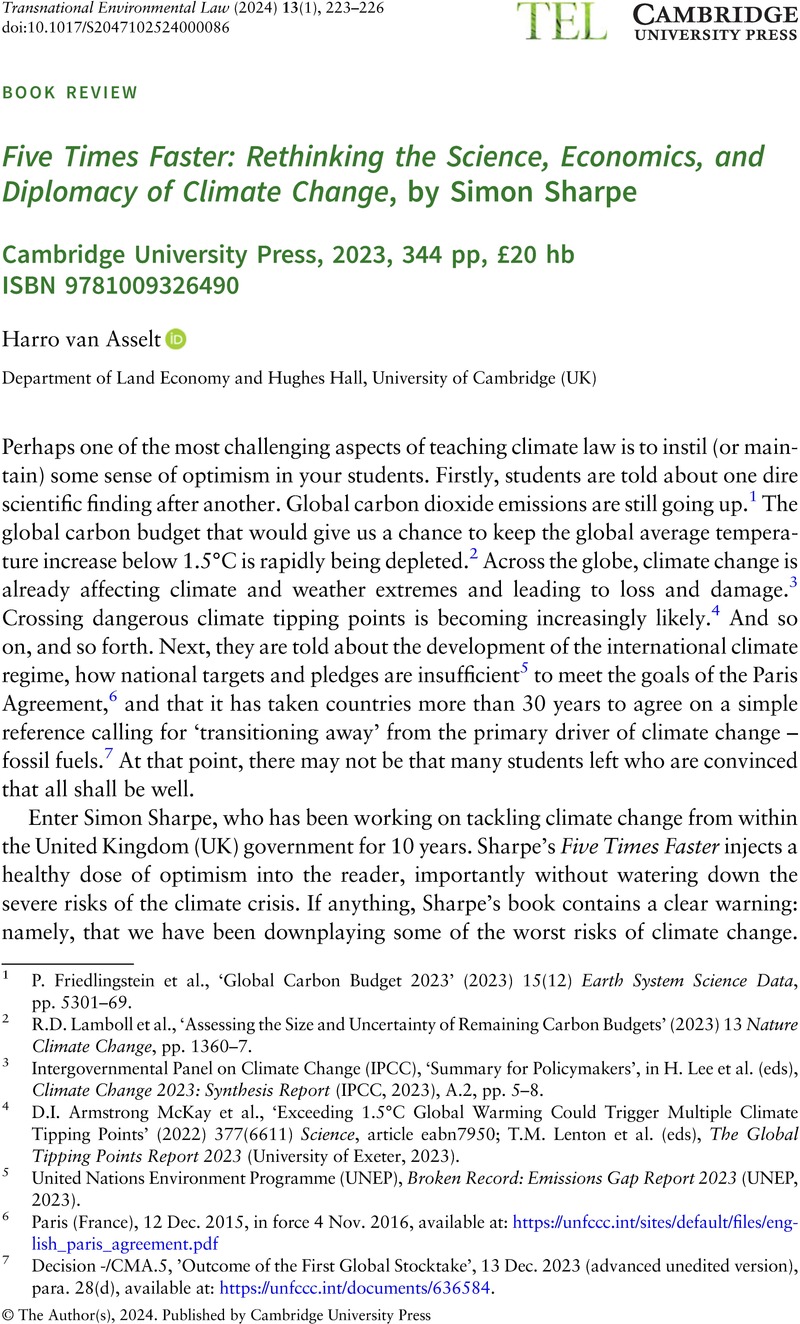No CrossRef data available.
Published online by Cambridge University Press: 15 April 2024

1 Friedlingstein, P. et al., ‘Global Carbon Budget 2023’ (2023) 15(12) Earth System Science Data, pp. 5301–69CrossRefGoogle Scholar.
2 Lamboll, R.D. et al., ‘Assessing the Size and Uncertainty of Remaining Carbon Budgets’ (2023) 13 Nature Climate Change, pp. 1360–7CrossRefGoogle Scholar.
3 Intergovernmental Panel on Climate Change (IPCC), ‘Summary for Policymakers’, in H. Lee et al. (eds), Climate Change 2023: Synthesis Report (IPCC, 2023), A.2, pp. 5–8.
4 D.I. Armstrong McKay et al., ‘Exceeding 1.5°C Global Warming Could Trigger Multiple Climate Tipping Points’ (2022) 377(6611) Science, article eabn7950; T.M. Lenton et al. (eds), The Global Tipping Points Report 2023 (University of Exeter, 2023).
5 United Nations Environment Programme (UNEP), Broken Record: Emissions Gap Report 2023 (UNEP, 2023).
6 Paris (France), 12 Dec. 2015, in force 4 Nov. 2016, available at: https://unfccc.int/sites/default/files/english_paris_agreement.pdf
7 Decision -/CMA.5, ’Outcome of the First Global Stocktake’, 13 Dec. 2023 (advanced unedited version), para. 28(d), available at: https://unfccc.int/documents/636584.
8 See similarly S. Keen, ‘The Appallingly Bad Neoclassical Economics of Climate Change’ (2021) 18(7) Globalizations, pp. 1149–77.
9 See also T.M. Lenton et al., ‘Operationalising Positive Tipping Points Towards Global Sustainability’ (2022) 5 Global Sustainability, article e1; Lenton et al., n. 4 above, section 4; J.D. Farmer et al., ‘Sensitive Intervention Points in the Post-carbon Transition’ (2019) 364(6436) Science, pp. 132–4.
10 L. Diaz Anadon et al., Ten Principles for Policymaking in the Energy Transition: Lessons from Experience (Economics of Energy Innovation and System Transition, 2022).
11 Ibid.
12 Geels, F.W. et al., ‘Sociotechnical Transitions for Deep Decarbonization’ (2017) 357(6357) Science, pp. 1242–4CrossRefGoogle ScholarPubMed.
13 Milkoreit, M., ‘Social Tipping Points Everywhere? Patterns and Risks of Overuse’ (2023) 14(2) WIREs Climate Change, article e813CrossRefGoogle Scholar, p. 8.
14 Again, lawyers should take note of the potential to apply transition theory to international law in the area of energy transitions. For a recent example see Hailes, O. & Viñuales, J.E., ‘The Energy Transition at a Critical Juncture’ (2023) 26(4) Journal of International Economic Law, pp. 627–48CrossRefGoogle Scholar.
15 New York, NY (United States), 9 May 1992, in force 21 Mar. 1994, available at: https://unfccc.int.
16 To get an idea of how such a global signal would appear, look no further than Decision -/CMA.5, n. 7 above, para. 28(g) (which very broadly calls for ‘[a]ccelerating the reduction of emissions from road transport on a range of pathways, including through development of infrastructure and rapid deployment of zero-and low-emission vehicles’).
17 Available at: https://poweringpastcoal.org.
18 Available at: https://www.globalmethanepledge.org.
19 Available at: https://cetpartnership.eu.
20 Available at: https://breakthroughagenda.org.
21 Chan, S. et al., ‘Assessing the Effectiveness of Orchestrated Climate Action from Five Years of Summits’ (2022) 12 Nature Climate Change, pp. 628–33CrossRefGoogle Scholar.